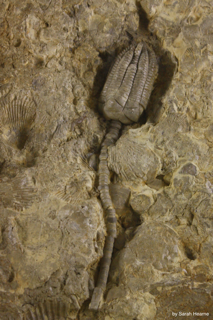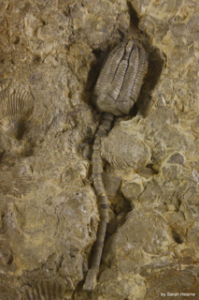One of the projects I’ve been working on recently has concerned diversity in the fossil record. In broad terms I’m looking at how diversity has changed over the last 540 million years, a period known as the Phanerozoic which starts at the Cambrian explosion and continues to this day. I want to try and understand what causes the periodic increases and decreases in diversity.
I’m not a palaeontologist, so this work has involved a massive learning curve in order to understand how we know what we know about the fossil record. What I’ve learned has led me to have an enormous respect for palaeontologists, but to also wonder whether some of the claims made on the basis of evidence from the fossil record may not be slightly overstated.
If we compared the fossil record to a court trial, I’d argue that the public perception is that the fossil record is rather like the court transcript: a full and complete record of the history of life on earth. Scientists outside the field of palaeontology probably understand that this is not true, and may liken it to more of a newspaper report on the trial: summarising, missing some details but the key facts are in place. The more I look into the fossil record, the more I think it seems like the hear-say testimony of an unreliable witness: heavily biased, missing important facts and giving probably erroneous information.
Before I get angry palaeontologists shouting at me I want to emphasise that that for short timescales or small areas I think the fossil record is brilliant and we can learn a lot about species turnover and ecosystem development. My concern comes from combining these short timescales and small areas and then using them to produce long timescale, global patterns of diversity. While it may seem like this is a sensible way to produce this data – who could possibly sample the entire earth for the entirety of the fossil record by themselves? – there are a number of so-called sampling biases that I feel make this approach potentially troubling. And while I have seen a great deal written about these biases and the efforts to reduce their effects, I have also seen research that makes me think these biases are impacting the data in ways we cannot predict.
So, after all that build-up, what are these biases? You’ll forgive me if I don’t discuss them all here, there are so many. Instead I’m going to split them into two groups and discuss these groups in very broad terms, focusing on the ones I think have the potentially biggest impacts on the patterns of diversity at the global scale. Proper palaeontologists have used a variety of different groupings, but I’ve grouped them into taphonomic biases and taxonomic biases. Taphonomy is the process of fossilisation but in this discussion it will also involve the process of the discovery of fossils. Taxonomy is the naming of species and there are a surprising number of biases that result from this seemingly simple process.
The most obvious taphonomic bias is that of the potential for fossilisation. It has been estimated that less than 10% of living species would end up in the fossil record and it would be heavily biased towards those organisms with bones or shells [1],. Many of the fossil diversity analyses are performed on molluscs as they have a good fossil record, so you might think that this would remove this problem. But the type of fossilisation affects how well an organism is preserved, if at all, and this affects molluscs just as much as other animals [2]. Plus, using molluscs assumes that they are a good model and representative of all organisms over all time which seems to be asserted without much evidence.
Another taphonomic bias is that of true sampling. At one end, not all environments are fossilised and at the other, not all fossil beds are studied by palaeontologists. In between, some fossil beds may be eroded over time and others may never reach the surface to be exposed for study. This leads to an effect called the ‘Pull of the Recent’ [3] whereby diversity increases towards the present day simply because there are more rocks available to study; the oldest ones have eroded, and the ones left are fewer in number the further from the present you go.
This sampling is not only biased in time, it is biased in space. There is a global trend in biodiversity, with highest levels at the equator and lowest at the poles, called the Latitudinal Diversity Gradient (LDG) [4]. This trend occurred throughout much, if not all, of the Phanerozoic and means comparisons of fossils between time periods must be from similar latitudes otherwise changes will say nothing about global diversity. While we may talk in terms of ‘global diversity’ it is often based on limited samples that may be predominantly from the tropics in one time period and temperate latitudes in another, yet this is rarely considered as a compounding factor when diversity is discussed.
Taxonomic biases are no less concerning. Naming fossils is more complex than naming living organisms, as the names must be based purely on the (potentially incomplete) skeleton. It is increasingly common to find living organisms that look identical but are genetically distinct species, and conversely organisms that look very different but are simply displaying phenotypic plasticity [5] yet fossils are named on the basis of their (potentially misleading) morphology which can significantly affect diversity estimates. Then there are problems of widespread fossils being given different names in different countries, or long-lived fossils being given different names in different geologic periods. Finally, there is the fundamental problem that the fossil record shows species evolving, and someone has to decide if and when a new species has formed and a new name applied. This will present itself in the data as an extinction and origination event, even when the population may not have changed in size or location.
These are just the very tip of an iceberg of biases. It may well be that palaeontologists have answers to all these biases and I have just failed to find the relevant literature. So far all I have found seems to be the claim (hope?) that all the biases will cancel each other out, leaving the true biological signal visible. I can’t be so certain. Indeed, my greatest fear is that the patterns of diversity are nothing more than the product of these biases and have little relation to the actual changes of diversity over the history of life on Earth. Reassurances to the contrary would be most welcome!
1. Nicol, D. (1977) The number of living animal species likely to be fossilised. Florida Scientist. 40, 135–139
2. Martill, D. M. (1998) Resolution of the fossil record: The fidelity of preservation. In The Adequacy of the Fossil Record (Donovan, S. K. and Paul, C. R. C., eds), pp. 55–74, John Wiley & Sons
3. Raup, D. M. (1972) Taxonomic diversity during the Phanerozoic. Science. 177, 1065–1071
4. Hillebrand, H. (2004) On the generality of the latitudinal diversity gradient. The American Naturalist. 163, 192–211
5. Bennett, K. D. (2013) Is the number of species on earth increasing or decreasing? Time, chaos and the origin of species. Palaeontology. in press,
Author and Picture Credit:
Sarah Hearne: hearnes[at]tcd.ie, @SarahVHearne


